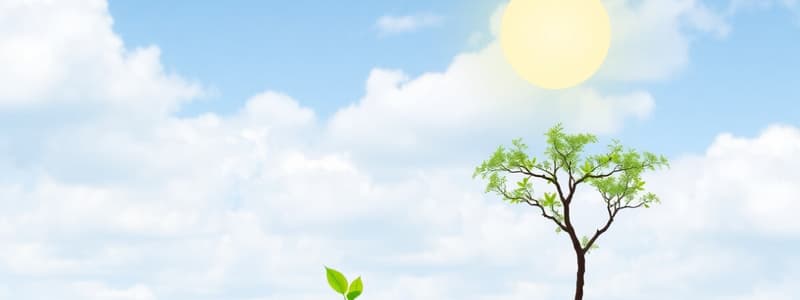Podcast
Questions and Answers
What does ecological resistance refer to?
What does ecological resistance refer to?
- The balance between different species in an ecosystem
- An ecosystem's ability to recover after being disturbed
- An ecosystem's ability to remain unchanged when faced with disturbances (correct)
- The natural ability of species to adapt to new environments
Which of the following events would test an ecosystem's ecological resistance?
Which of the following events would test an ecosystem's ecological resistance?
- The introduction of non-native species
- Regular seasonal temperature changes
- A hurricane hitting the coastal region (correct)
- Migration of birds south for winter
Why is ecological resistance important for ecosystems?
Why is ecological resistance important for ecosystems?
- It enables ecosystems to maintain functionality despite disturbances. (correct)
- It protects ecosystems from all forms of disturbances.
- It ensures that all species remain present in the ecosystem.
- It helps ecosystems flourish indefinitely without any change.
What is a potential outcome of low ecological resistance?
What is a potential outcome of low ecological resistance?
Which factor is least likely to influence an ecosystem's resistance?
Which factor is least likely to influence an ecosystem's resistance?
What is one significant health effect caused by ozone depletion?
What is one significant health effect caused by ozone depletion?
How does ozone depletion impact plant life?
How does ozone depletion impact plant life?
What significant observation has been made regarding the ozone layer over Antarctica?
What significant observation has been made regarding the ozone layer over Antarctica?
Which organization conducted studies that confirmed the presence of a growing ozone hole?
Which organization conducted studies that confirmed the presence of a growing ozone hole?
What does increasing ozone depletion primarily threaten?
What does increasing ozone depletion primarily threaten?
What role do institutions play in shaping behavior related to environmental impacts?
What role do institutions play in shaping behavior related to environmental impacts?
Which of the following is a method institutions might use to influence environmental behavior?
Which of the following is a method institutions might use to influence environmental behavior?
Which statement best describes the effectiveness of communication strategies used by institutions?
Which statement best describes the effectiveness of communication strategies used by institutions?
What is the primary goal of using incentives in environmental behavior strategies?
What is the primary goal of using incentives in environmental behavior strategies?
How do individual and collective environmental impacts relate to each other?
How do individual and collective environmental impacts relate to each other?
What is the ecological footprint of the US?
What is the ecological footprint of the US?
How does the total land area of the US compare to its ecological footprint?
How does the total land area of the US compare to its ecological footprint?
What is the total land area of the US in hectares?
What is the total land area of the US in hectares?
What implication does having an ecological footprint greater than total land area have?
What implication does having an ecological footprint greater than total land area have?
Which of the following statements about the US's ecological footprint is true?
Which of the following statements about the US's ecological footprint is true?
What type of practices did Indigenous peoples of the Pacific Northwest engage in regarding resource use?
What type of practices did Indigenous peoples of the Pacific Northwest engage in regarding resource use?
Which statement best describes the sustainability practices of Indigenous peoples in the Pacific Northwest?
Which statement best describes the sustainability practices of Indigenous peoples in the Pacific Northwest?
Which of the following is a characteristic of the sustainable practices of Indigenous peoples?
Which of the following is a characteristic of the sustainable practices of Indigenous peoples?
Why is the sustainable use of resources practiced by Indigenous peoples important?
Why is the sustainable use of resources practiced by Indigenous peoples important?
What can be inferred about the resource management strategies of Indigenous peoples based on their sustainability practices?
What can be inferred about the resource management strategies of Indigenous peoples based on their sustainability practices?
Flashcards are hidden until you start studying
Study Notes
Ecological Resistance and Resilience
-
Ecosystems can maintain their structure and function in the face of disturbances like hurricanes and wildfires. This is called ecological resistance.
-
Ozone depletion can have serious consequences, including increased skin cancer rates and hindered plant growth.
-
NASA studies confirmed the existence of a growing ozone hole over Antarctica.
Influencing Decisions
- Institutions utilize incentives and communication strategies to encourage individuals to reduce their environmental impacts.
Individual and Collective Environmental Impacts
- The US has a land area of 983 million hectares, but its ecological footprint exceeds 2.6 billion hectares. This indicates unsustainable resource consumption.
Historical Sustainability Practices
- Indigenous peoples, such as those in the Pacific Northwest, practiced sustainable resource use for generations.
Studying That Suits You
Use AI to generate personalized quizzes and flashcards to suit your learning preferences.




